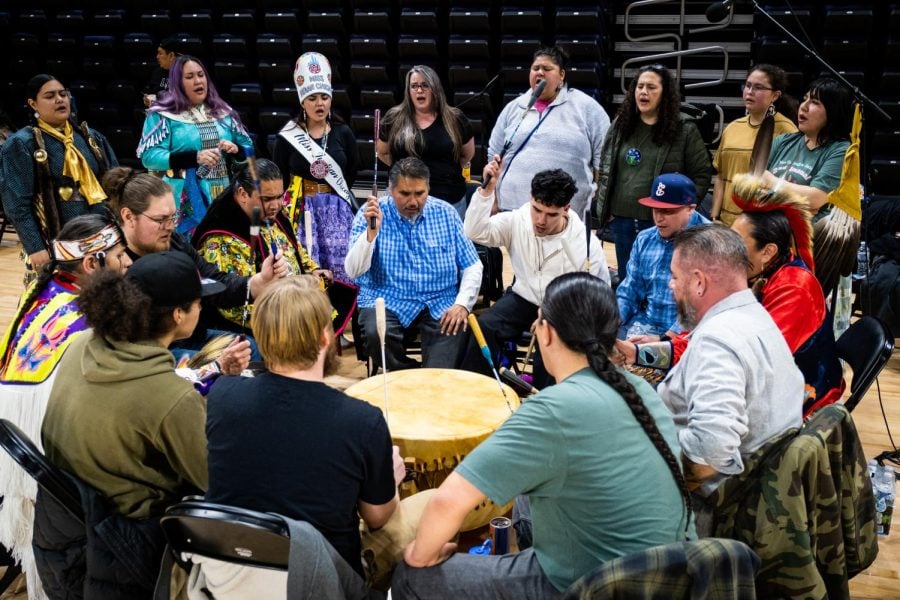‘The land is our relative’: NAISA hosts second annual Pow Wow on Earth Day
The Oka Homma drum circle. The Chicago-based drum singers were one of the invited drum groups at NAISA’s second Pow Wow and presented intertribal songs of the Southern Plains.
April 24, 2023
Content warning: This article contains mentions of death and anti-Indigenous violence.
When the Native American and Indigenous Student Alliance learned Earth Day was an option for its second annual traditional spring Pow Wow, SESP sophomore and Pow Wow Planning Committee co-Chair Alivia Britton, who is Odawa, said “Honoring the Land” became the obvious theme.
“The land is so integral to being Indigenous and that relationship is something that our people really value and respect,” said Britton, who is also NAISA’s treasurer. “The land is our relative, so it just makes sense to honor that.”
More than 200 Native and non-Native people gathered in Welsh-Ryan Arena to celebrate the local Indigenous community and the Earth on Saturday. Through song, dance and other forms of tradition, the Pow Wow commemorated the cultures of tribes and nations across the Midwest and beyond.
Northwestern’s Evanston Campus sits on the traditional homelands of the people of the Council of Three Fires — the Ojibwe, Potawatomi and Odawa — and the Menominee, Miami and Ho-Chunk nations. John Evans, a co-founder of NU, played a significant role as governor of the Territory of Colorado in the 1864 Sand Creek Massacre that killed about 230 Cheyenne and Arapaho people.
The Pow Wow began with the Grand Entry, a procession led by military veteran Vincent Romero — who is Laguna Pueblo — holding an Eagle Staff. Veterans were followed by dancers, visiting royalty, and other community members and guests. The ceremony also commemorated the late Bill Smith, a Lakota military veteran who died in 2020.
The celebration featured exhibition dances and drum group performances, while Indigenous artisans and organizers worked at tables providing educational information and sold handmade cultural goods to attendees.
NAISA co-Chair and Weinberg sophomore Athena GoingSnake, who is a citizen of the Cherokee Nation and Muscogee Creek, said the Pow Wow is a step toward increasing both internal growth and NAISA’s connections to the larger University and regional Indigenous communities.
“The number-one thing is that we’re trying to build this really strong foundation for us so we can build off that and advocate for ourselves and teach others about us and our presence on campus,” GoingSnake said. “But this Pow Wow was a really good example of how we’re trying to share with the wider Northwestern community.”
University Chaplain the Rev. Kristen Glass Perez, who is enrolled in the Leech Lake Band of the Minnesota Ojibwe, presented her blessings at the event. She said there is “beauty and necessity” in every season, and that people must treat every day like a celebration of the Earth.
University President Michael Schill also spoke at the Pow Wow and said the University is taking institutional steps to enhance the Indigenous presence on campus through programming. He also announced a new scholarship for Native American and Indigenous students.
Communication sophomore and Pow Wow Planning Committee co-Chair Mel McDaniel — who is Tyme Maidu of Berry Creek Rancheria of Oroville, California — said NAISA has many more initiatives it wants to accomplish. The group hopes to work with NU to create a Native American and Indigenous studies department and hire more Native faculty.
But, she said, the alliance does not have much people power. The class of 2025 came in at about 1.6% Native and Indigenous, according to the University. NAISA has about 15 members, according to GoingSnake.
For McDaniel, the Pow Wow is a way to engage in conversations about Native people outside the history of genocide, one of the “only” narratives she heard growing up.
“We want people talking about Native people outside of the harsh history,” McDaniel said. “We want people to see that it’s also a celebration of culture and we’re brought together to find collective joy.”
On May 5, the Center for Native American and Indigenous Research at NU will launch the wiigwaasi-jiimaan, also known as the birch bark canoe, into Lake Michigan. The canoe, built in 2021 by then CNAIR artist-in-residence Wayne Valliere, will then be displayed in the Segal Visitors Center.
Britton said she hopes Pow Wow attendees will become more aware of the everyday choices they make in relation to the environment. Indigenous communities are a foreground for addressing environmental challenges –– including climate change –– because their cultural practices that are proven to help the environment, she said.
Increasing the visibility of Native stories is a top priority for her.
“Turning (the Pow Wow) into tradition is so important to us,” Britton said. “We want to have it so Native students, when they get here, they feel seen and have a space to actively celebrate and be in community with each other in a space that’s created for them by them.”
Email: [email protected]
Twitter: @joannah_11
Email: [email protected]
Twitter: @rjleung7
Related Stories
— Native American and Indigenous Student Alliance hosts NU’s first Pow Wow
— 30 Days of Indigenous celebrates histories and cultures
— NAISA commemorates 158th anniversary of the Sand Creek Massacre


